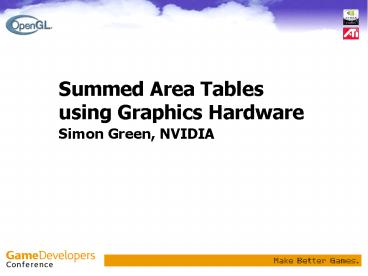Summed Area Tables using Graphics Hardware - PowerPoint PPT Presentation
Title:
Summed Area Tables using Graphics Hardware
Description:
In Computer Graphics 18, 3 (July 1984), pp. 207-212. ... Summed-Area Tables for Texture Mapping. Proceedings of SIGGRAPH `84. In Computer Graphics 18, 3 ... – PowerPoint PPT presentation
Number of Views:612
Avg rating:3.0/5.0
Title: Summed Area Tables using Graphics Hardware
1
Summed Area Tables using Graphics Hardware
- Simon Green, NVIDIA
2
What are Summed Area Tables (SATs)?
- Pre-integrated texture representation
- Invented by Frank Crow, 1984
- Each texel is the sum of all texels below and to
the left of it - Allows rapid box filtering (average) over any
rectangle for a fixed cost - Based on the algebraic identity
- (xa)(yb) (xa)y x(yb) xy ab
3
Summed Area Table
Summed area table
Regular image
1 1 1 1
1 1 1 1
1 1 1 1
1 1 1 1
4 8 12 16
3 6 9 12
2 4 6 8
1 2 3 4
4
Summed Area Table
a
(x, yb)
(xa, yb)
(0, yb)
b
(x, y)
(0, y)
(xa, y)
(x, 0)
(xa, 0)
(0, 0)
ab Sxa, yb Sxa, y Sx, yb Sx, y
5
Original Image
6
Summed Area Table (scaled)
7
SATs on Graphics Hardware
- Floating point textures have sufficient precision
to represent SATs - Can decode SAT using a fragment program
- Enables texture lookup with any width box filter
for constant cost (4 texture lookups math) - Amount of blur can vary from pixel to pixel
(spatially variant)
8
SAT Texture Decode
// look up into summed area table texture//
returns average of pixels in rectangle with
corners (x,y) - (xa,yb)float4
texRECT_summedArea(uniform texobjRECT tex, float2
xy, float2 ab) float4 r r
f4texRECT(tex, xy ab) //
Sxa, yb r r - f4texRECT(tex, xy
vec2(ab0, 0) ) // Sxa, y r r -
f4texRECT(tex, xy vec2(0, ab1) ) // Sx,
yb r r f4texRECT(tex, xy)
// Sx, y return r / (ab0 ab1)
- Bilinear lookup requires 4 bilinear lookups into
float texture, followed by SAT decode - May also require clamping texture coordinates to
avoid problems at edges
9
Building Summed Area Tables using Hardware
- For dynamic applications (e.g. depth of field),
we need to be able to create SAT textures
on-the-fly - Possible using render-to-texture
- Sum columns first, and then rows
- Each row or column is rendered as a line
primitive - Fragment program adds value of current texel with
texel to the left or below - Can be done using render to active texture, but
warning - results undefined!
10
Building Summed Area Table
1 1 1 1
1 1 1 1
1 1 1 1
1 1 1 1
1 2 3 4
1 2 3 4
1 2 3 4
1 2 3 4
4 8 12 16
3 6 9 12
2 4 6 8
1 2 3 4
Original image
Sum columns
Sum rows
- For n x m image, requires rendering2 x n x m
pixels, each of which performs two texture
lookups - Other algorithms may be possible
11
Applications of SATs
- Anisotropic texture filtering
- Can be better than mip-mapping
- Rectangle may not match projection of pixel
exactly - Depth of field
- Blur image of scene based on distance
- Higher quality blur than using mipmaps
- Soft shadows
- Blur image of shadow based on distance from
occluder
12
Depth of Field Demo
13
References
- Crow, Frank. Summed-Area Tables for Texture
Mapping. Proceedings of SIGGRAPH 84. In Computer
Graphics 18, 3 (July 1984), pp. 207-212.

